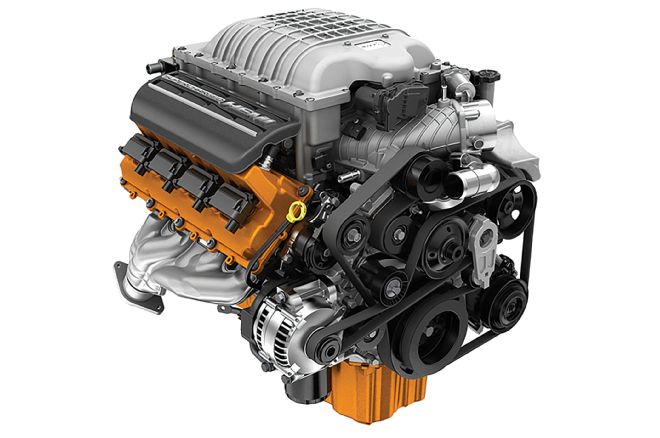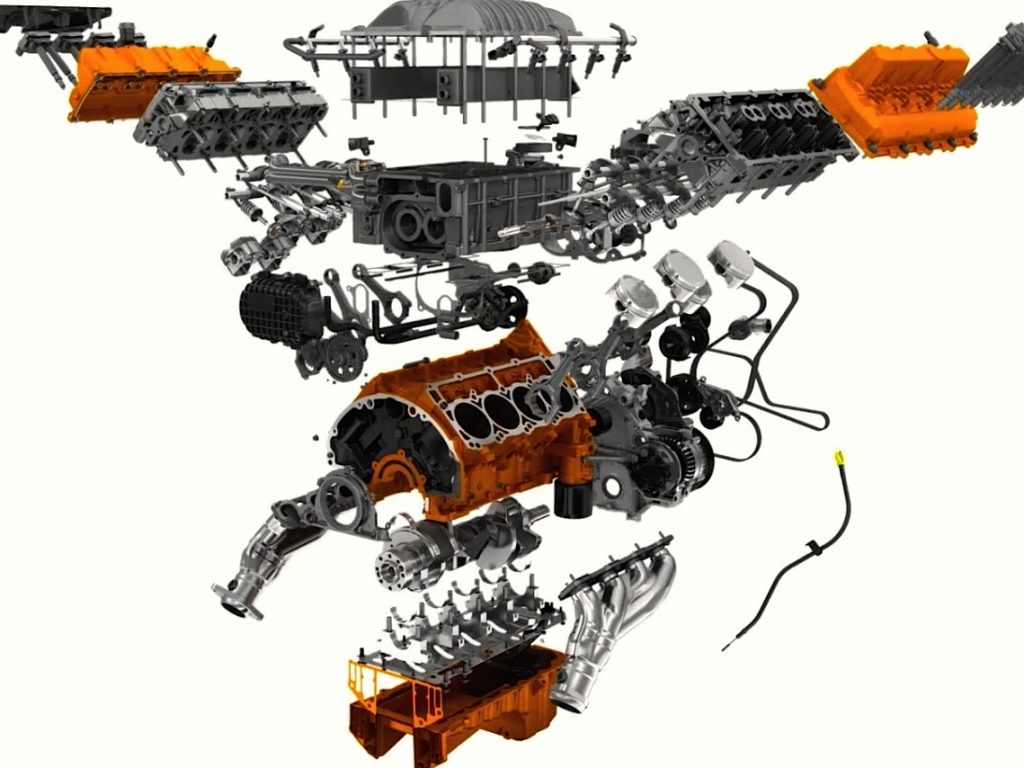Editor’s note: The 1980s was a transition period for engine technology in America. The iconic carburetor gave way to fuel injection. Cubic inches were out, and liter designations marked a new era for engines — one when power and fuel economy were no longer mutually exclusive. This modern engine age has featured some of the best innovation, technology, and performance yet.
#2 – Third Generation Chrysler HEMI
First, a little history.
Most enthusiasts know that the modern HEMI (marketing name) isn’t technically a “hemi” (a technical designation referring to an engine’s hemispherical combustion chambers), but just in case there’s any confusion, know this:
Today’s HEMI isn’t a “hemi.”
At least not like the original designs from the early 1900s, nor those made famous by Chrysler’s legendary 426-cubic-inch “Elephant” which made Mopar a household name during the original American muscle car era.
Today’s HEMI engines still have valves opposing central spark plugs, but not the hemispherical combustion chamber inside.
A clear line has been drawn in the sand between the famed Hemi of yesteryear and today, but they have something in common:
Both engines are formidable and magnificent.
The 5.7L Eagle
It was 14 years ago, when a brilliant advertising campaign by Chrysler reintroduced the American public to the HEMI name. Suddenly, people who didn’t know how to check tire pressure were walking around asking: “That thing got a HEMI in it?”
The first of the third-generation HEMI engines—the 5.7L V8—launched for model year 2003 in the Dodge Ram pickup trucks, and later found their way into Dodge’s Durango, Magnum, Charger, Challenger, the Chrysler 300C, and the Jeep Grand Cherokee.
Like the famed Hemis of yesteryear, the 5.7 is rated at about one horsepower per cubic inch. Inside the ’03 Ram truck, the new HEMI produced 345 horsepower and 398 ft.-lbs. of torque. It used a coil-on-plug, distributorless ignition system and two spark plugs per cylinder to shorten flame travel. This lead to more consistent combustion and reduced emissions.
Many of the new HEMI-powered vehicles featured new-at-the-time variable displacement technology—Chrysler’s Multi-Displacement System (or MDS), which would deactivate four of the V8 cylinders under light loads and steady speeds.
Chrysler revised the 5.7 for the 2009 model year, introducing Variable Valve Timing. This new addition improved fuel economy, increased horsepower to 357-395, and built torque to 389-410 ft.-lbs., depending on the application.
The 6.4L/392 HEMI Apache
Just two years into the Gen. III HEMI era, Chrysler introduced a bigger and badder mill—the 6.4L. There are special-edition Dodge Challengers with the “392 HEMI” badge, and crate engine versions are sold as 392 HEMIs, but the 6.4 is a different block and build than the crate engine.
The 6.4L HEMI produces as much as 485 horsepower and 475 ft.-lbs. of torque in the modern Dodge Challenger and Charger. The 392 crate engine version is rated for 525 horsepower and 510 ft.-lbs of torque.
Then for 2015, Chrysler changed the world and we all appropriately lost our minds.
The 6.2L Hellcat
For 2015, Chrysler made the correct decision to unleash the most powerful domestic production engine ever. The supercharged 6.2L Hellcat V8 makes 707 horsepower. The end.
*drops mic*
Just kidding. But what more needs said? Hot Rod took a long, detailed up-close look at the Hellcat, and walks us through every engine part and how it’s similar or different from the Apache. It’s worth a look.
Not everyone’s impressed by power numbers. But most of us are.
And this piston-firing superhero is a major part of the Gen. III HEMI (marketing name) rising to #2 on our list, despite not technically being a Hemi.
Gen. III HEMI Modifications
If you own a third-gen. HEMI, here are some commonly sold parts to keep it running:
The 5.7L
The 6.4L (392)
The 6.2L Hellcat
You can see the current list of our Top Engines of the Last 30 Years here.



” two spark plugs per cylinder to shorten flame travel. This lead to more consistent combustion…” Yes, it does shorten flame travel time but consistency is not a benefit. It allows for shorter ignition advance (less time working against combustion during compression).
Can you jerks stop saying the “Hemi” is just a name when referring to The 3rd Gen Hemi? The 3rd Gen engines are real hemi’s, especially the ones with heads produced since 2009. Are they the perfect bowl shapes of the Fire Power & 426 Hemi? No, the eagle & hellcat heads are very close to traditional hemi engines and the early 5.7s are complex but the theory is still the same. What used to be cast on top of the pistons to increase compression, is not done in the cylinder to reduce piston weight for a faster revving engine. For the record the first 5.7 Hemi’s have a perfect round dome on the piston, so is that not hemispherical itself? I think you guys got infatuated with that Motortrend Rain on Chryslers parade article and kept running with it 14 years later.
The fact is these engines retain every major advantage of a traditional chrysler hemi plus a few for the street to give it some manners. The complex chamber shape of the first 5.7 Hemi 03-08 is just a streetable Hemi, for quick burn quench areas for emissions and better low end response and light weight pistons for faster revs all to help its street cred. Funny how people will call the 4.7 Chrysler V8 the Hemi’s little brother, the Boss 429 a Hemi (sometimes called a semi hemi, has more in common with a Big Block Chevy & 409 than any hemi), the australian Hemi 6 with nearly wedge shaped chambers but yet a real hemi (3rd Gen Chrysler Hemi) you jerks won’t even give a nod to as a real hemi. Very very sad. Its a Hemi get over it fools.
As usual They ignored the “6.1”Hemi? The Power of the 208-09-2010 , Challengers etc. They introduced the 392cid /aka 6.4 Hemi, for 2011 and later..Then the 6.2/ 376cid Supercharged Hellcat Red Eye Demon all variants of it all of them are not Forged Except maybe the Demon, and Hellaphant not 100% sure on that. The 6.1 370cid had a forged Crank & they all suffer from oil problems at the Cam shaft and lifters. “Poor design ” ? also 5.7’s were pron to dropping valve seats in the 5.7 Heads Another poor design.They make power with the right parts But they all charge cubic dollars for them. You’ll need to get forged internals to safely boost them. The cars need a DIET to be competitive. My 2010 6.1 Manual SRT8 Challenger has over 100k on it and is still running great Tremec trans is a weak point, had to replace it had trouble with it right from the start grinding going into 3rd gear told dealer they said there was nothing wrong..it finally jammed and I had to replace /rebuild it.
[…] we dive into the results (like you haven’t already), let’s first get to the Mopar Gen III Hemi test motor, then each of the […]
Great job!